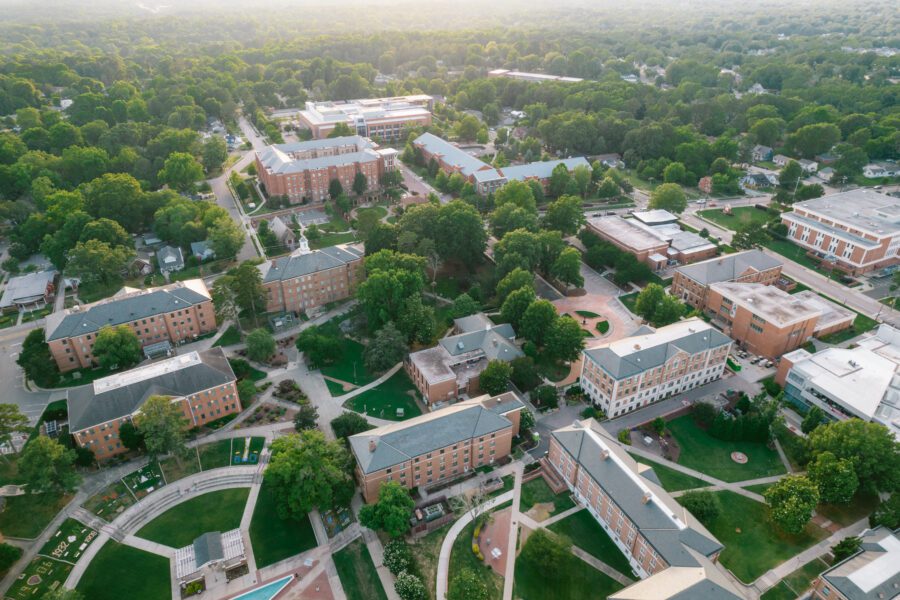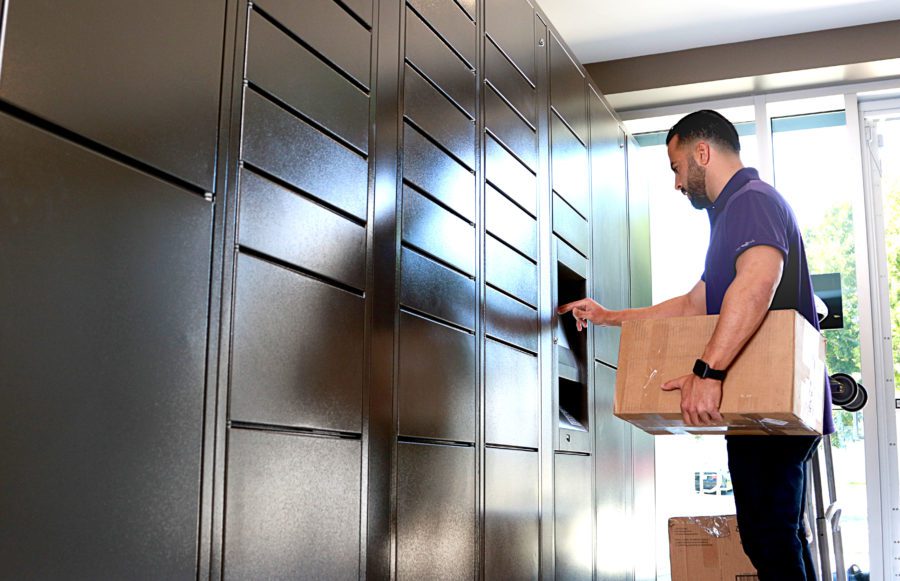
Our Blog
How to Improve College Library Services
Written by: Parcel Pending
5 Min Read
Published: December 30, 2023
Updated: September 5, 2024
It’s a brave, new world when it comes to college library services. After maintaining a reliable suite of library resources and services for many years, college libraries are now evolving to keep up with students’ changing needs in the post-pandemic collegiate experience.
Although a simple definition of a library’s role is that of the keeper of books, a better explanation comes from Shan Sutton, Dean of University Libraries at the University of Arizona: “We are a library that still holds to the mission of leveling the playing field for all students.”1 Today, that mission translates into adding and adapting the following vital student services.
Invest in More Digital Resources
Digital transformation is at the top of the list for most library administrators. Not surprisingly, investment in print resources is at the opposite end of the school library service spectrum. According to a recent survey among library deans and directors, if a 10% budget reduction were mandated, 54% would cut the print monograph budget, and 45% would decrease the print journal subscription budget.2
Incorporate Digital Searching and Checkout
Most college libraries today have invested in RFID self-service kiosks, security gates, and dedicated library apps, but not all. These technological library service improvements directly translate into lower labor costs.
Add Smart Speaker Technology
With over 500 million people using Apple’s Siri technology worldwide, speech recognition is here to stay.3 It leads to better search results for library resources, as humans add more details to voice searches than keyword searches.
Focus on Technology and Hardware Investment
Podcast equipment, 3D printers, maker spaces, and data centers are pivotal to the next generation of students – and to university campus improvement ideas as a whole. Students at the University of Arizona can borrow GoPro and Canon cameras, Lenovo and MacBook laptops, and Microsoft Surface Pro tablets.
Create Private Study Spaces
Over 500 college students were surveyed about how they use library spaces. Almost 59% responded that the top reason for spending time in the library was for a “quiet study space.”4 Libraries are leaning into this research with soundproofed rooms and unique quiet study spaces to help improve the overall campus experience.
Install Group Collaboration Spaces
Comfy desk chairs, giant video screens, electrical outlets, desks, and movable furniture are essential to ensure success with library group student spaces. Many universities also offer webcams, videoconferencing, and reservations for group study areas – dorm amenities some institutions may not be able to provide.
Add Creative Tools
Citing the philosophy that college students need job-ready skills, Adobe recently donated $100K to the University of New Mexico to create the Adobe Creative Commons.5 Adobe’s Creative Campus initiative focuses on giving students access to graphic design, video creation, and podcast tools.
Offer Fast, Free Internet
With textbooks, assignments, and syllabi transforming into digital data and experiences, university students expect, if not demand, free, fast internet throughout the library and campus as part of their university’s standard student services.
Employ Smart Lockers for On-Demand Check-Out
Parcel Pending by Quadient created the Campus Hub™ which acts as a central distribution system for the transfer of library books as well as other documents or library equipment rentals. Instead of students having to pick up a book only during library hours, the smart parcel lockers are typically installed to be available 24/7/365. Students receive a notification via text or email to retrieve their goods by entering a six-digit PIN or scanning a barcode at the electronic locker kiosk. The system can also work as a returns mechanism.
Introduce Tutoring and Study Sessions
Offering regular, organized tutoring and study sessions gives students a reliable resource when they’re in need of extra help with their coursework. Sam Houston State University, for instance, has opened the First-Generation Center and Academic Success Center, which offer mentoring and tutoring resources.6,7 “The goal is for the library to become a one-stop shop for academic services and support, so when students need certain things, they know where to go,” says Lisa Shen, the campus director of library public services.8
Go Beyond the Books
Look into lending e-books, movies, videos, and free streaming services to libraries such as Libby and Hoopla. These and other digital services help make multimedia learning more accessible for students.
Offer AI Classes
With Artificial Intelligence’s seismic change to the web and beyond, harnessing its power and understanding its limitations are critical for the next generation of learners. ChatGPT, Midjourney, Bard, and DALL-E all take time to learn better prompts and provide better results. Determine when and where your institution can implement generative AI technologies, and consider circulating AI guidelines and policies where applicable.
Improve Accessibility
New thinking on accessibility in higher education now includes neurodiverse students and those with physical disabilities. Neurodiversity includes dyslexia, dysgraphia, ADHD (Attention-deficit/hyperactivity disorder), and other mental illnesses. The latest research shows that ADHD affects 6.1 million children in the United States, and the diagnosis rate rose a whopping 42% between 2003 and 2011, with few children growing out of the condition before reaching college.9 Modern libraries are accommodating the mobility of wheelchairs to move throughout the spaces and ramps in addition to elevators. Creating study and collaborative spaces with wide aisles and adjustable desks also work to support various students with disabilities.
Campus libraries have already morphed into a laptop-first institution. The next step is offering students resources, spaces, and learning that prepare them for jobs or future study.
Ready to learn more about how university smart lockers can augment your institution’s library services? Please speak to one of our parcel management experts today.
Sources:
- Wong, Wylie. University Libraries Evolve to Support Future Needs. edtechmagazine.com. February 10, 2023. https://edtechmagazine.com/higher/article/2023/02/university-libraries-evolve-support-future-needs
- D’Agostino, Susan. Librarians’ ‘New Normal’ Includes Pain Points. www.insidehighered.com. April 6, 2023. https://www.insidehighered.com/news/2023/04/06/librarians-new-normal-includes-pain-points
- Breakell, James. Five Trends Shaping the Library Experience in 2023. d-techinternational.com. January 19, 2023. https://d-techinternational.com/2023/01/19/five-trends-shaping-the-library-experience-in-2023/
- Scoulas, J., & De Groote, S. (2022). Impact of Undergraduate Students’ Library Use on Their Learning beyond GPA: Mixed-Methods Approach. College & Research Libraries, 83(3), 452. doi:https://doi.org/10.5860/crl.83.3.452
- Velasquez, Sara. The collaborative team behind the Adobe Creative Commons. news.unm.edu. February 1, 2022. https://news.unm.edu/news/the-collaborative-team-behind-the-adobe-creative-commons
- Sam Houston State University. First-Generation Center. www.shsu.edu. August 17, 2022. https://www.shsu.edu/dept/firstgen/
- Sam Houston State University. Academic Success Center. www.shsu.edu. July 19, 2014. https://www.shsu.edu/centers/academic-success-center/
- Wong, Wylie. University Libraries Evolve to Support Future Needs. edtechmagazine.com. February 10, 2023. https://edtechmagazine.com/higher/article/2023/02/university-libraries-evolve-support-future-needs
- Winkler, Rolfe & Nassauer, Sarah. Walmart, CVS Pharmacies Have Blocked or Delayed Telehealth Adderall Prescriptions. www.wsj.com. April 27, 2022. https://www.wsj.com/articles/walmart-cvs-pharmacies-have-blocked-or-delayed-telehealth-adderall-prescriptions-11651082131



